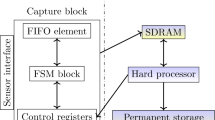Abstract
Image/video processing in real-time is always in high demand for the quality of video. There are several factors which cause the loss of the video content, such as the type of transmission, missing data and especially data switch. Data switch generally occurs in the alternation of the video signal, which can cause the discontinuity of data during the video data stored in buffer or memory. The current method which adopts frame difference for detecting this issue may consume many resources and memory footprint. This paper presents a method which uses the video pixel prediction to detect the freezing event. The method is implemented with a video system which employs the System-on-chip (SoC) architecture with Field Programmable Gate Array (FPGA) and other components including DDR3 ram, flash, and exchange interfaces as the main processing platform that prevents this problem through freezing detection. The result of evaluation shows that the accuracy of the proposed method is above 99%, in terms of saving more logic usage and reducing the footprint of the memory on the video system.











Similar content being viewed by others
References
Alavi M, Leidner DE (2001) Knowledge management and knowledge management systems : Conceptual foundations and research issues. Manag Inf Syst Res Center 25 (1):107–136
Apperson RW, Yu Z, Meeuwsen MJ, Mohsenin T, Baas BM (2007) A scalable Dual-Clock FIFO for data transfers between arbitrary and haltable clock domains. IEEE Trans Very Large Scale Integr (VLSI) Syst 15(10):1125–1134
Chien S, Ma S, Chen L (2002) Efficient moving object segmentation algorithm using background registration technique. IEEE Trans Circ Syst Video Technol 12 (7):577–586
Davis J, Goadrich M (2006) The relationship between Precision-Recall and ROC curves. In: 23Rd international conference on machine learning. ACM, New York, pp 233–240
Dorbian F, Awan A, Joseph D, Ganjam A, Zhan J, Sekar V, Stoica I, Zhang H (2011) Understanding the impact of video quality on user engagement. In: ACM Special interest group data communication conference. IEEE, Toronto, pp 362–373
Huynh-Thu Q, Ghanbari M (2009) No-reference temporal quality metric for video impaired by frame freezing artefacts. In: 16Th international conference image processing. IEEE, Cairo, pp 2221–2224
ITU (2007) ITU-R recommendation BT.656 ITU-T Rec
Karam L, Ebrahimi T, Hemami S, Pappas T, Safranek R, Wang Z, Watson A (2009) Introduction to the special issue on visual media quality assessment. IEEE J Sel Top Signal Process 3(2):189–192
Kim K, Chalidabhongse TH, Harwood D, Davis LS (2005) Real-time foreground-background segmentation using codebook Model. Real-Time Imaging 11 (3):172–185
Kumbhare P, Krishna V (2014) Designing high-performance video systems in 7 series FPGAs with the AXI Interconnect. Xilinx, CA, pp v1.3
Laplante PA (1997) Real-Time Systems design and analysis. IEEE Press, NJ
Li J, Xu T, Zhang K (2017) Real-Time Feature-Based Video stabilization on FPGA. IEEE Trans Circ Syst Video Technol 27(4):907–919
Li P, Lilja DJ (2011) A low power fault-tolerance architecture for the kernel density estimation based image segmentation algorithm. Application-specific Systems, Architectures and Processors, ASAP. IEEE Santa Monica. https://doi.org/10.1109/ASAP.2011.6043264
Li Y, Wang G, Nie L, Wang Q, Tan W (2018) Distance metric optimization driven convolutional neural network for age invariant face recognition. Pattern Recogn 75:51–62
Marwedel P (2006) Embedded System Design, 1st edn. Springer, New York. https://doi.org/10.1007/978-94-007-0257-8
Nagai Y, Okamawari T, Fujii T (2016) A novel streaming method using QoS control function of LTE to prevent video freezing. In: Wireless communications and networking conference, WCNC. IEEE, Doha. https://doi.org/10.1109/WCNC.2016.7564971
Pedre S, Krajník S, Todorovich E, Borensztejn R (2016) Accelerating embedded image processing for real time: a case study. J Real-Time Image Proc 11 (2):349–374
Seshadrinathan K, Soundararajan R, Bovik AC, Cormack LK (2010) Study of subjective and objective quality assessment of video. IEEE Trans Image Process 19(6):1427–1441
Shuang Y, Yifan W, Fang M (2014) The comparison and improvement of data processing methods in video quality subjective assessment. In: 7Th international congress image and signal processing. IEEE, Dalian, pp 612–616
Stauffer C, Grimson W (1999) Adaptive background mixture models for real-time tracking. In: Computer vision and pattern recognition conference. IEEE, Fort Collins, pp 246–252
Škobić V, Marić U, Tomić S (2016) Real time video freezing detection implementation on FPGA. In: 24Th telecommunication forum TELFOR. IEEE, Belgrade, pp 1–3
Xue Y, Erkin B, Wang Y (2015) A novel No-Reference video quality metric for evaluating temporal jerkiness due to frame freezing. IEEE Trans Multimed 17(1):134–139
Yammine Y, Wige E, Simmet F (2012) Blind frame freeze detection in coded videos. In: Picture coding symposium. IEEE, Krakow, pp 341–344
Yan H, Li X, Wang Y, Jia C (2018) Centralized Duplicate Removal Video Storage System with Privacy Preservation in IoT. Sensors 18(60):1813
Author information
Authors and Affiliations
Corresponding author
Additional information
Publisher’s note
Springer Nature remains neutral with regard to jurisdictional claims in published maps and institutional affiliations.
Rights and permissions
About this article
Cite this article
Nian, TK., Chondro, P. & Ruan, SJ. A low complexity detection method for video data discontinuity implemented on SoC-FPGA by using pixel location prediction scheme. Multimed Tools Appl 79, 22261–22276 (2020). https://doi.org/10.1007/s11042-020-09021-2
Received:
Revised:
Accepted:
Published:
Issue Date:
DOI: https://doi.org/10.1007/s11042-020-09021-2




